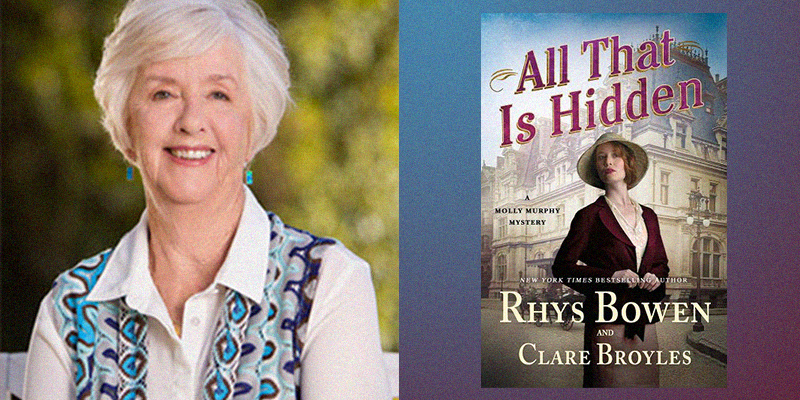Rhys Bowen is the author of the long-running Molly Murphy series, set in turn-of-the-century New York City, as well as stand-alones and another historical series. Rhys was kind enough to answer a few questions over email about historical fiction, crafting memorable heroines, and her latest Molly Murphy story, All That Is Hidden.
Molly Odintz: What draws you to historical fiction?
Rhys Bowen: I am drawn to the first half of the Twentieth Century because it is connected to my own time through my parents, grandparents and their stories. It is in some ways so familiar and yet so distant. I could take you on a walking tour of Molly’s New York and find it all pretty much unchanged, and yet I write about a time when half the population couldn’t vote, when husbands essentially owned their wives and children died of simple diseases.
Also writing mystery novels set in the period gives my sleuth a challenge. It is not the sterile crime solving of CSI. There are few forensics and the sleuth must rely on wits and observation. No DNA to solve the case.
MO: What should writers keep in mind when crafting an enjoyable yet detail-rich historical novel? How do you balance historical world-building and action?
RB: My aim when I write is to take the reader to the time and place, not tell them about it. So no long descriptions to take us out of the action, but it’s the small details that remind us where we are: a certain smell, the lacing of a corset, trying to run with all those long skirts. Also seeing everything through our heroine’s eyes, experiencing what she experienced. That brings the past to life.
If we are setting a story in a particular time and place it all has to be correct. So lots of research to get everything right. Clare reads the NY Times for every day we write about. At the beginning of the series I used to walk every street that Molly walked and notice what I saw, smelled, felt. We use real stories as starting points, like the mail bag episode and the ferry sinking in our latest book, ALL THAT IS HIDDEN. And we bring on real characters in cameo roles like William Randolph Hearst in this book.
MO: What is the key to keeping a long-running series fresh?
RB: I have to enjoy writing it, not take it for granted and go through the motions. Every story has to be fresh and new. If I am enjoying myself, then the reader will too. We are lucky with Molly as there are endless stories of New York and the immigrant experience. Molly finds herself mingling with high society, as in this story, or with gangs and slums, or even outside the city as in the next book. Also the characters have to grow as the series progresses. Molly started off as a naïve young woman fresh from Ireland, fighting to prove her innocence in Murphy’s Law. Now at book 19 she is a wife and mother, secure and loved, but also with that nagging desire to prove herself and use her talents.
MO: Why do you think audiences have so engaged with your heroines, beloved now to readers across the globe?
RB: I think readers can identify with so much about my heroines. In both series they are naïve at the beginning, struggling to make their own way in a difficult world. Molly is feisty, finds it hard to control her temper, has a strong sense of justice but is not always wise in her decisions. The reader wants to cheer her on. And the reader also appreciates in later books where she chafes at being just a wife and mother and wants to make a contribution to society.
MO: Can you talk a bit about your latest book? Do you need a break from series characters every now and again?
RB: This is Molly book 19 and is called ALL THAT IS HIDDEN. Molly finds herself ill at ease when whisked to a grand house on Fifth Avenue and mingling with powerful people like Big Bill McCormack who heads Tammany Hall and is running for major. Also to her horror, she finds her husband is running for office on the same ticket. He begs her to trust him and she does until a major player is murdered. Then, of course, she finds herself involved in solving the murder. It is another story that shows Molly torn between the demands of motherhood, handing a teenage daughter, and her profession.
I find that writing two very different series keeps me fresh. I always look forward to returning to Molly after Lady Georgie and vice versa. And writing the big stand alone novels in between is definitely a challenge but one I adore as I can explore so many different settings. But I currently write two and a half books a year. This is crazy. I’m hoping to slow down a little in future, if my publishers will let me and looking forward to Clare gradually taking over Molly.
MO: Who are some of your biggest literary influences?
RB: Naturally my first influences came from the ladies of the Golden Age, who inspired my love of mystery, but it was Tony Hillerman who was my impetus to write mystery novels. I was blown away by the way he took the reader to a place, made the reader feel she was there, and gave insights into Navajo culture. Brilliant!
MO: Last but not least: you’re casting the ideal adaptation of your series heroines. Who plays Maisie Dobbs? Who plays Mollie Murphy?
RB: It would have to be a real Irish actress to get the feel of the accent and intonation. I think Saoirse Ronan would be fine!
***


















